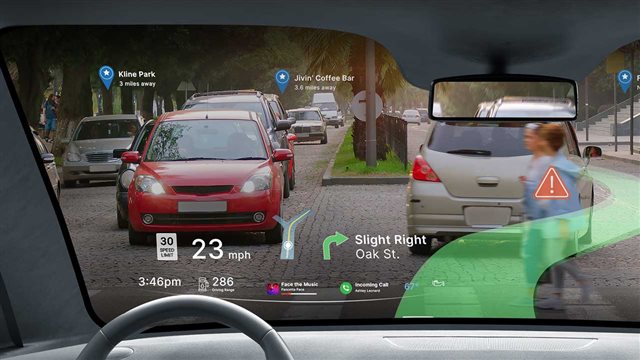SSZT048 December 2022 DLP4620S-Q1

The future of head-up displays (HUD) has been rapidly changing as vehicles become more electrified and connected. Specifically, augmented reality (AR) HUDs have become a centerpiece of smart cockpit designs and can help improve the overall driving experience with driver assistance and safety features. There are several technical considerations to keep in mind when designing a next-generation AR HUD.
Field-of-view (FOV) and Virtual Image Distance
Field-of-view is perhaps the most important aspect of an AR HUD solution because it directly impacts the size of the image the driver sees. DLP® technology, like the DLP4620S-Q1 DMD, can enable a larger than 15-degree field-of-view, making it possible to project information to the driver across more lanes.
The virtual image distance dictates the throw distance of an image and how far out the image appears to float in front the driver. This is particularly important at higher speeds, when more advanced notice of things like road hazards are necessary. Current AR HUD designs using DLP chips can project images that appear anywhere from 2 to 20 meters in front of the driver, significantly expanding the virtual image distance compared to traditional HUDs as shown in Figure 1.
 Figure 1 The Range of AR HUD Image Distance with DLP Technology.
Figure 1 The Range of AR HUD Image Distance with DLP Technology.Image Quality
It’s important to note that image quality doesn’t necessarily equate to higher resolution in this scenario. Image quality involves several variables including image refresh rate, color depth, brightness, etc. Unlike the local movie theater, it can be very challenging to control the image quality in a chaotic and somewhat unpredictable outdoor automotive environment. The varying light levels throughout the day and night mean any automotive AR HUD solution must be able to maintain deep, accurate colors and consistently high contrast ratios to work across a range of driving conditions.
For example, our DLP4620S-Q1 automotive-qualified chipset can be coupled with LEDs or lasers and an optical system to enable deeply saturated colors up to 125% of the NTSC color gamut. The DMD also enables an extremely high brightness of more than 15,000 cd/m2 and features a high dynamic dimming ratio of more than 5000:1. These features combined help deliver vibrant images to drivers in a variety of environments.
Development Options
Most automotive AR HUD solutions require developers to collaborate on a solution that meets the needs of their products and customers. AR HUD solutions are part of an integrated solution featuring advanced driver assistance systems (ADAS) and other components that work collectively to deliver an improved driving experience.
At TI, we have a legacy of working with developers and the TI Design Network of affiliated partners to help them create products and services that tap into our broad portfolio of semiconductor device solutions.
Conclusion
An AR HUD enables the windshield to become the focal point for all relevant data such as speed and road hazards while keeping the driver’s eyes focused on the road ahead. As vehicles continue to become more connected, AR HUDs can help increase driver and occupant safety and improve the overall driving experience. DLP technology will continue enable high-performance resolution, brightness, efficiency, contrast, and color to help automotive designers project the next generation of AR HUDs.
Additional Resources:
- Watch how DLP technology enables next-generation, wide FOV AR HUDs.
- Learn more about automotive-qualified DLP technology.